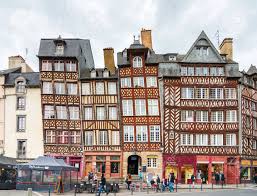They say history, culture and language make us islanders constantly look North. But a new reason has emerged in the past year or more: we can’t fly South.
Do you recall those days when our airline Aurigny would fly a little Trislander regularly to Dinard? You could slip away for a weekend, consume French food and wine in a different milieu, tour historic sites in Normandy and Brittany, stay at chateaux or campsites, play some golf or surf.
For reasons which remain unexplained, Aurigny stopped the flights. Not enough demand, perhaps? Well, they shouldn’t have started running fewer flights at inconvenient times. And did we as an island promote Guernsey to the French? Rhetorical question.
Now it has emerged that Aurigny has asked for permission to fly to Rennes. It has received no answer from the Committee for Economic Development which determines these things. The committee says it can’t find an operator. But representatives of the TransManche Development Group, an initiative of the Franco-British Chamber of Commerce, visited Guernsey recently and endorsed the proposal.
If you stop and think about it, it is a good idea. The number of visitors to the Island from France during the summer high season (third quarter) totalled 15,838 this year, almost double the same period the previous year and in sharp contrast to the decline seen in the number of UK nationals. In recent years around 7%-9% of the typical annual total of visitors (275,000-285,000) have come from France, a proportion similar to the number from neighbouring Jersey. Jersey does better, but we now have Victor Hugo’s house, kindly renovated at French government expense, and it is attracting increased numbers.
Would we islanders use a direct flight to Rennes? It would be surprising if we didn’t. It is a short flight of perhaps 45 minutes. It has a small, modern airport, more akin to London City or Southampton than Gatwick. It re-introduces a novelty destination. And it is easy to use, offering more connections elsewhere than most people realise, without terminal transfers, long walks or – importantly – congestion.
So take note:
- Onward flights. There are direct connections to Cork, Dublin, Manchester, London City, London Southend, Southampton, Madrid, Majorca, Barcelona, Corsica, Corfu, Amsterdam, Palermo and, within France, Paris Roissy, Strasbourg, Bordeaux, Toulouse, Marseille, Nice and Lyon. The airlines include Air France, Flybe, EasyJet, Aer Lingus and Vueling. Most offer daily services throughout the year. Those who wish to travel further might even use this hub rather than Gatwick or Southampton. In some instances Rennes may be more attractive on the basis of timetabling. After that much depends on the price.
- Fast rail. Rennes has a major railway station with comfortable frequent trains to Paris in under 90 minutes. France has invested heavily in high speed rail networks now coming into service. Other trains run to many towns and cities locally, including St Malo, Combourg, Dol and Vitré and further afield throughout France. Links from the airport to the station are straightforward. The taxi rank is convenient, the journey is 20 minutes and 20 Euros, or there is a bus every 10 minutes for 2 Euros. For islanders wanting to visit Paris, Rennes might offer the quickest option and potentially the cheapest – again, depending on the fare.
- Rennes itself. This is the capital of Brittany – it has an opera house, it invests more widely in the arts, it has a major league football team. But its biggest investments have been in upgrading the railway station, the airport, a large visitor centre in an old monastery and, since 2002, an underground rail system running northeast to southwest. A second line is being built northwest to southeast to connect to the airport and railway station in 2020.
This, then, is a city which has grown enormously around its outskirts, as anyone motoring along the rocade around Rennes will have noticed. Banks, professional services firms, digital services businesses, hotels and restaurants point to an expanding and well-served conurbation constituting one of the ten largest cities in France with reportedly the third largest city economy.
Rennes may therefore present some unexpected business opportunities for Guernsey if accessibility in both directions improves. Apart from that, it is a great jumping off point for a clutch of amenities – including impressive golf courses once so happily used by Guernsey players. Simple to conclude, then, that an airlink to Rennes would make sense. But while this won’t be news to islanders who still visit France, past experience means considerable planning is required.
Some important issues will demand attention if this idea is to go any further:
- Subsidy. A dread subject in recent weeks as Aurigny, Blue Islands and FlyBE have gone head to head on existing routes, forcing taxpayers to dig into their pockets even as consumers benefit from lower fares. Initial thoughts are that about 4,000 passengers a year might use the Rennes route, and that it is almost bound to need support, whichever operator takes it on.
- Flight scheduling. They should be direct and not part of a triangle route (there has been a suggestion of Guernsey-Rennes-Exeter) – otherwise there is no time advantage in foregoing the current use of Condor Ferries. Departure and arrival times are important too. Aurigny’s service to Dinard offered daily flights and, crucially, two on Fridays and Sundays allowing passengers to leave Guernsey at 1700 on Friday and return at 1900 Sunday or 0800 Monday. This kept time off work to a minimum – until the airline effectively abandoned its customers.
- Competition. Well, potential competition, of a sort: Jersey commercial bodies are conducting a survey on air routes direct to Rennes. A number of permutations suggest themselves if these separate routes are to be profitable rather than loss-making. The possibilities include cooperation rather than competition, to both islands’ benefit.
- Facilitating road travel elsewhere. Apart from the obvious requirement of rental car services, the annual charge of 700 Euros to keep a car at the airport is high and likely to discourage second-home owners. In addition, travel to local areas not served by trains would be helped with connecting bus services rather than prohibitively expensive taxis – otherwise, again, visitors might prefer to use Condor in order to have their own car.
- Reliability. Islanders forced to use Condor to get to France are frustrated. While weather problems are understood and accepted, poor timetabling, in particular the lack of direct ferries, makes it difficult for Guernsey travellers to go to France from the beginning of October to the end of April. Trans-shipping in Jersey, waiting for the second leg, travelling very early or late – it all stands in unattractive contrast with Jersey travellers, who enjoy daily ferries throughout the year, and often twice a day.
All in all, you would think that, between the TransManche Development Group and officials in both Guernsey and Brittany, it ought to be possible to develop a closer and a mutually profitable connection between Guernsey and its southern neighbour. Done thoughtfully, passenger numbers from Guernsey ought to climb back easily to those seen in the days of the Trislanders and Shorts 360s. Done determinedly, the aircraft should be full in the other direction too.







